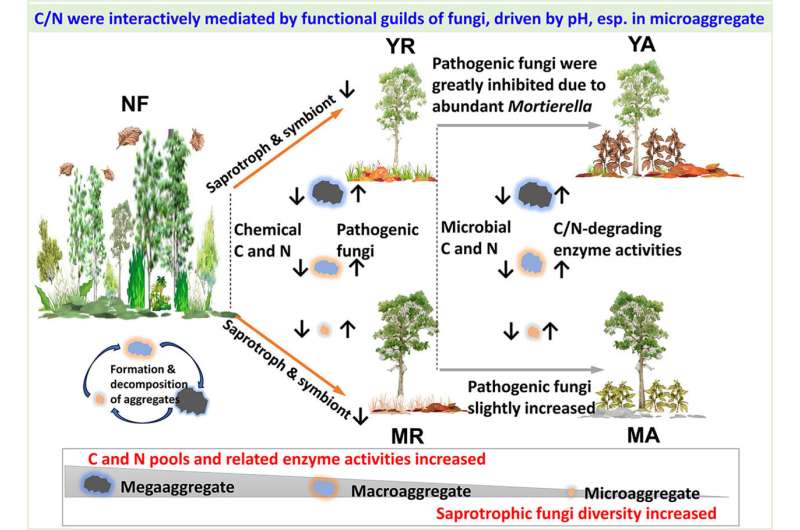Study provides insight to early establishment of agroforestry systems in tropical areas

Land use change is one of the greatest threats to soil biodiversity and ecological functions. Tropical deforestation to establish monoculture cash tree plantations poses the greatest threat to biodiversity. However, how such a transition affects soil carbon (C) and nitrogen (N) dynamics driven by fungal communities at the aggregate level remains unclear.
In a study published in Science of The Total Environment, researchers from the Xishuangbanna Tropical Botanical Garden (XTBG) of the Chinese Academy of Sciences assessed the impact of tropical land use change on soil fungal functional guilds and the effects on soil C and N cycling processes at the aggregate level.
The researchers determined C and N fractions, fungal communities, enzymatic activities and chemical properties within three soil aggregates in a natural forest, 12- and 24-year-old rubber monocultures and corresponding agroforestry systems in Xishuangbanna, southwest China.
They found that the differential land use change on soil C and N dynamics were mediated by fungal functional guilds across aggregate sizes. The C and N pools in all aggregates were generally reduced when tropical forests were converted to rubber monocultures. Microbial C and N biomass decreased in agroforestry systems.
Carbon- and N-degrading enzyme activities responded differently to forest conversion and were increased in agroforestry systems. As the soil aggregate size decreased, the levels of C and N pools and associated enzyme activities increased.
In addition, pathogenic fungi increased at the expense of saprotrophic and symbiotic fungi with forest conversion. Soil aggregate size influenced fungal diversity rather than composition, with microaggregates having the highest diversity.
C and N pools within aggregates were variedly affected by fungal functional guilds, mainly driven by soil pH, regardless of land use type. According to the researchers, all the differences were attributed to changes in species diversity, soil properties and associated agroforestry management.
"Our study provides an important insight into the early establishment of agroforestry systems in tropical cash tree plantations due to the greater benefits in nutrient cycling and pathogen control," said Liu Chenggang of XTBG.
More information: Chenggang Liu et al, Land use change alters carbon and nitrogen dynamics mediated by fungal functional guilds within soil aggregates, Science of The Total Environment (2023). DOI: 10.1016/j.scitotenv.2023.166080
No comments:
Post a Comment